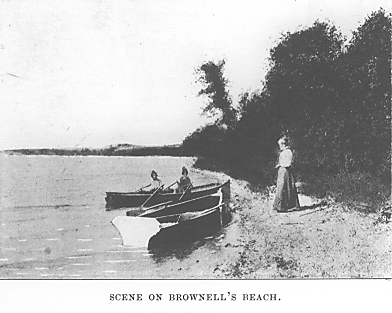CHAPTER XLI.
RESORTS ON WEST OKOBOJI—ARNOLDS PARK—ITS GROWTH—VARIETY OF ENTERTAINMENT—THE ANNUAL SHOOTING TOURNAMENT—MILLERS BAY—THE POPULAR FISHING GROUND—THE OBSERVATORY—THE HIGHEST LAND IN IOWA—WHAT PROFESSOR MACBRIDE SAYS OF IT—SMITHS POINT—OKOBOJI BRIDGE—SOME OF THE EARLY VISITORS—THE BOTANY CLASS OF THE STATE UNIVERSITY—THE OKOBOJI POSTOFFICE—THE LATER RESORTS ON WEST OKOBOJI—MANHATTAN BEACH—THE INN—GILLEYS BEACH—HAYWARDS BAY—PIKES POINT—BROWNELLS BEACH—EGRALHARVE—WILLOW SPRING FARM—POCAHONTAS POINT—PILLSBURYS POINT.
THE EARLY stopping places on West Okoboji were Arnold's Park, Miller's Bay and Smith's Cottage. Arnold's Park is on the site of the first improvements in the county made subsequent to the massacre, made by J. S. Prescott in the summers of 1857 and 1858. Some five or six years later the residence was destroyed by fire and Prescott moved another building about sixteen by twenty feet in size and one story high on the same site where he was living when he sold out to Blake & Arnold. This one story, one roomed house was a famous stopping place in the early days. No matter how much they were crowded "Wet" could always find room for one more. The low banks, sandy shore, clear water and adjacent grove made this a famous camping place long before a summer resort was thought of.
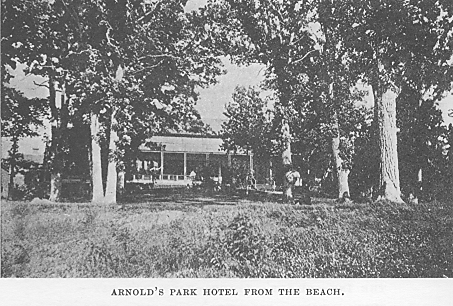
Well, as summer business began to develop and summer visitors commenced making their annual trips "in search of sport and western game," Arnold commenced building "he knew not what." Whenever his business demanded an additional building he put it up wherever there was room for it regardless of plats or plans. He commenced building about 1873 and has kept it up at pretty regular intervals ever since, until he has quite a village all his own. Anything and everything that tends to attract and interest a promiscuous crowd is found here in abundance. The hotel proper with the cottages furnish accommodations for from two to three hundred guests and on occasion by a little crowding more can be cared for. Arnold's Park is coming to be the "storm center" for excursions over the Milwaukee road, which are every year growing in number, magnitude and popularity.
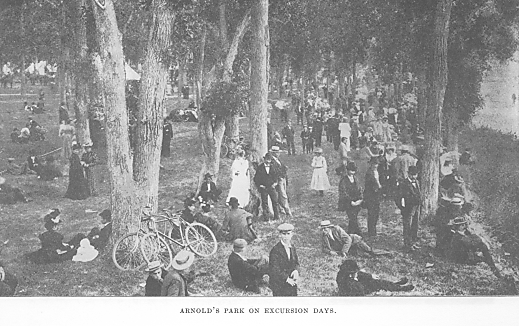
The amusements for which facilities are afforded are many and varied. A large pavilion with a roomy stage, and a thousand chairs, furnishes facilities for public gatherings of every kind. Sermons, lectures, concerts, theatricals and dancing parties alternate with each other in pretty regular succession, although the dancing parties are usually somewhat in the lead. Boating, bathing and fishing are the aquatic sports provided for. Steamers, sailboats and rowboats are at the dock every hour in the day. Here also is the highest toboggan slide ever erected in the lake region. The person who never' went down a toboggan slide into the water below has missed a very exciting experience. When first introduced they were a great fad, but of late have attracted less attention.
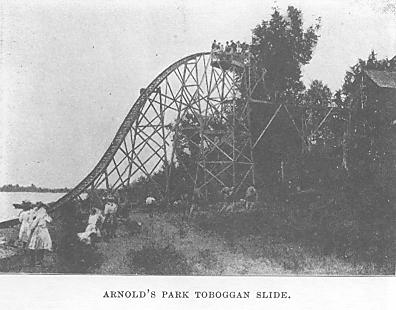
Pool, billiards and tenpins are largely indulged in, to say nothing of the more questionable and exciting games. It is a cosmopolitan company that annually meets here for their summer vacation. Here the zealous young preacher, who conscientiously bears the burden of looking after the spiritual welfare of his flock, "touches elbows" with the flashily dressed "sporting man" who is always ready to "buck the tiger" on occasion, while lawyers, doctors, editors, traveling men and college professors help to swell the crowd.
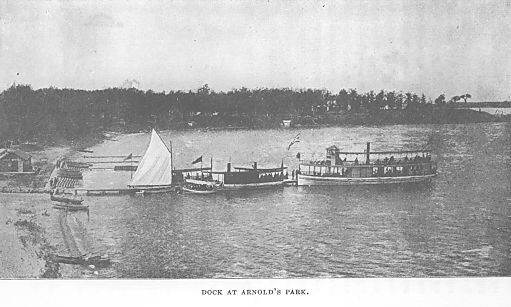
Of the many events yearly "pulled off" at the park none are more popular or attract more attention than the annual shooting tournament, where trials of skill in live bird and trap shooting are arranged and the celebrities in that line from all parts of America, meet here to contest for trophies and championships. Fred Gilbert, who has won more prizes in this line and captured more trophies and held them longer than any other person living, was a Dickinson County boy and one of the products of the "pioneer days" and it is related of him that he acquired his amazing skill as a "wing shot" by shooting blackbirds in his father's cornfield when a mere "kid" of from eight to twelve years of age. His great advantage lies in his wonderful celerity or quickness of aim, and as before stated this quickness was acquired in shooting blackbirds in the early days when they were a great nuisance.
Miller's Bay is another of the old time favorite camping grounds. Miller was one of the first settlers on the west side of West Okoboji Lake, and his place was situated just right to form an ideal camping ground. Like many others, Miller's accommodations at first consisted of only a farm house, and a small one at that, but parties who were partial to that side of the lake so importuned him that he finally erected accommodations consisting of office, dining room and sleeping rooms for a limited number, where he entertained substantially the same old crowd year after year, winning deserved popularity he afterwards laid off a large number of lake shore lots under the name of West Okoboji
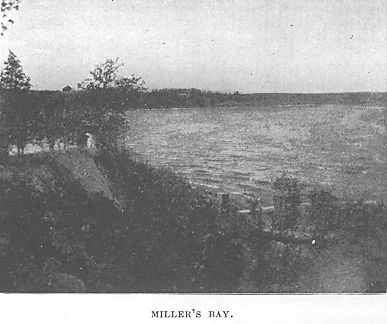
Miller's Bay is popularly supposed to be the finest fishing ground about the lakes. West Okoboji is known to be by far the deepest, of the lakes and the bottom the roughest and most uneven; that is, there are places where it drops off abruptly from a depth of thirty or forty feet to nearly two hundred. This peculiarity is more marked in that part of the lake between Fort Dodge Point and Miller's Bay than anywhere else, and these pools or deep places in the bottom of the lake are supposed to keep up the supply of fish after the shallower places are exhausted.
Overlooking Miller's Bay from the west on what is known as the Willow Spring Farm, is a high hill or mound chimed by some to be the highest land in Iowa. On the top of this mound a kind of observatory has been erected and the place pointed out to the summer tourists as the highest point between the "Alleghanies" and the "Rockies." An amusing incident is related of the captain of one of the early steamers, who by the way, although one of the best fellows in the world, was a little inclined to be pompous and consequential in his manner. At that time trips from the Orleans down through East Okoboji and over into West Okoboji were very popular. On one occasion a party of intelligent ladies and gentlemen were making the trip when one of the men, noticing the observatory, asked the captain what it was and what it meant. The captain at once struck a dramatic attitude and answered somewhat pompously: "That, ladies and gentlemen, is the highest point of land in Iowa, seventeen thousand feet high, ladies and gentlemen." This so amused the gentleman that when he repeated it to his companions they conspired to put up a job on the captain by each in turn dropping into conversation with him and casually asking some question about the observatory, and to each he had the same stereotyped reply, "That is the highest point in Iowa, seventeen thousand feet high, ladies and gentlemen."
This mound, too, was the place pointed out to the unsophisticated summer tourist as the grave of Okoboji, and many a sentimental scribbler has exhausted his stock of adjectives and adverbs in writing high sounding homilies over the pile of sand and gravel which was pointed out to him as the grave of the mythical chieftain.
Now as to what in truth is the highest point in Iowa, there is some difference of opinion. What may or may not be the highest point about the lakes is uncertain, but the preponderance of testimony is in favor of a high peak in a cluster of knobs near the northeast corner of section one, in Lakeville township. There are several other points of about the same altitude, but none of them are as high as some points in Osceola County. Prof. T. H. MacBride, in his report on the geology of Dickinson and Osceola Counties, discusses this point very entertainingly. He says:
"The most remarkable of all these hills, a beautiful object in itself, and by far the most elegant illustration of its type, is the long time famous Ocheyedan* mound.
(*Pronounced O-chee-dan; Nicollet has this to say: "Otcheyedan—a name derived from a small hill, the literal meaning of which is 'the spot where they cry'; alluding to the custom of the Indians to repair to elevated situations to weep over their dead relatives."— Nicollet, Report of the Upper Mississippi River, etc., p. 27.)
This is a prairie mountain, a precipitous mound or peak, rising at last abruptly from the general surrounding level. It is situated in the south-west one-fourth of the southwest one-fourth of section 12, in township 99, range 40, west, on the east bank of the Ocheyedan Valley, and about one mile southeast of Ocheyedan town. One hundred and seventy feet above the valley flood-plain, and at least twenty feet higher than any surrounding land, it has long been a landmark and is visible at their homes to hundreds of citizens of Osceola County. The height above sea level, as estimated from data furnished by railway surveys, is not far from 1,670 feet, one of the highest points in Iowa, its only rival the summit of the moraine in Wilson township northwest of Allendorf, which has probably about the same elevation."
Another of the early day camping grounds which was very popular was at the crossing of the straits between East and West Okoboji. This was known as Smith's Point. All of the north and south travel through the county converges at this point, it being the only place for fully three miles either east or west that the lakes can be crossed. Here was erected the first bridge built in the county. Previous to the bridges people crossed as they could. At the first election the boys from the north side of the straits swam over and those who couldn't swim, paddled themselves across on poles or chunks of wood. Most of the teaming at that time was done by ox teams and many of them soon learned as soon as they reached the water to strike for the other side without any hesitation. Where the couplings of the wagon were properly secured and the box lashed to the running gear, if the box was reasonably tight and the driver level headed, a team that understood their business would cross and make a landing on the opposite side without danger of accident. The distance they had to swim was about thirty feet. The strait was something over two hundred feet wide, but was fordable except the thirty feet in the center.
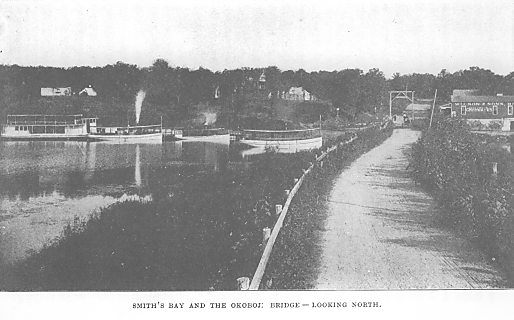
The first bridge was a footbridge, made of small logs flattened on one side and laid on trestles. After this was one with trestles strong enough to bear a team. On these were laid stringers and these stringers covered with ten foot plank. In the fall of 1860 came the county bridge. In 1873 M. J. Smith erected a dwelling house afterwards pretty well known as Smith's Cottage.
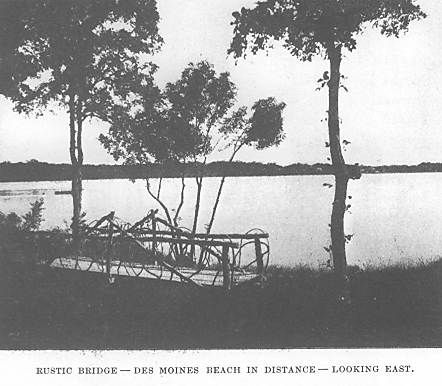
At this time nobody comprehended what the summer resort business was to be in the near future, and everyone planned his building to suit his own taste or convenience, regardless of what the public might demand hereafter, and Smith's Cottage was planned and built without any thought of its being opened as a summer resort, but the convenience of the location, together with its natural attractions, early made it a favorite stopping place for many of the prominent people of the state. The late Senator Gear, who was an enthusiastic sportsman and very skillful with the rod, spent some time here every fall during his term of office as Governor. He was invariably accompanied by his wife and usually one or more of the state officers. Judge Given also in an early day spent his annual vacation in camp at Okoboji. Before the era of cottages or railroads, he, in company with a large party of friends and congenial spirits, used to come here, bringing with them their tents and camping outfit. Usually they pitched their camp "on the brow of the hill" overlooking Okoboji bridge, where they established headquarters, and untrammeled by the conventionalities which have come to be a part of the life of the more recent years, they gave themselves up for the time being to the enjoyment of the rest and change their surrounding's afforded.
Judge Given exhibited the same qualities of intelligence and good sense in arranging and managing a summer camp that he has always manifested in other matters. He has the happy faculty of making every man, woman and child with whom he comes in contact believe he is their particular personal friend, and the consequence is there isn't a "kid" in the whole lake region but thinks the Judge is about the greatest man in Iowa, and, by the way, the Judge seems to enjoy this kind of popularity fully as much as he does the laurels he won on the field or the honors that have since been accorded him on the bench.
In 1885 M. J. Smith laid off some lake shore lots and offered them for sale under the name of Okoboji Park. Judge Given was the first to purchase one of these lots and one of the first to build a cottage thereon, and it was in this way that the place came to be known as "Given's Point." George Dimmit of Des Moines built the first cottage at Okoboji. That year and the next several Des Moines parties purchased lots and built on them, and have in the main occupied them ever since, although some changes have occurred and it was for this reason the place came to be known as "Des Moines Beach."
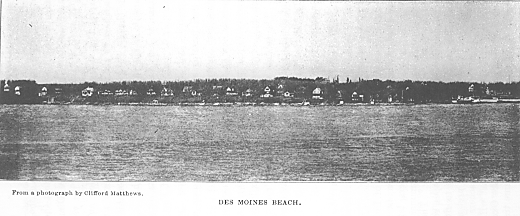
In like manner Fort Dodge Point received its name. A party of some six or eight prominent citizens of Fort Dodge purchased grounds, laid off lots and built cottages in close proximity, thus forming a community of their own, and the place has since been known, as Fort Dodge Point.
A movement is now on foot to interest the authorities of the State University in the project of founding here a summer school, which shall serve as a kind of annex or auxiliary to that institution. The scheme was originated by Prof. T. H. MacBride, of the chair of botany. An Iowa City correspondent of the Des Moines Capital, under date of July 27, 1901, writes of the enterprise as follows:
"STUDENTS AND TEACHERS OF THE STATE UNIVERSITY GO TO THE "LAKES TO STUDY THE FLORA AND FAUNA THERE."
"Iowa City, July 27. -- Iowa's first summer school of botany held under the auspices of the State University of Iowa, will open at Lake Okoboji Monday. At 8:30 o'clock last night a party of students, twenty in number, with teachers, left Iowa City for Lake Okoboji, the headquarters of the summer school, the party having leased cottages in that locality. They took with them a large equipment of the finest microscopes, reagents, etc., leaving behind no paraphernalia necessary to fit out a laboratory that would do credit to a university of pretension.
"Those of the party who intend to become teachers of botany will prepare at Okoboji sets of material that will be of especial value in their chosen field of work. Lake Okoboji is particularly rich in aquatic plants, and at the same time possesses the additional desirableness of having a rare combination of prairie, timber and water conditions that will appeal with force to botanists in search of good material. The school will last two weeks and will be in charge of Prof. B. Shimek. Dr. T. H. MacBride, now engaged in working for the state geological survey, will visit the school for, a brief time. The experiment will be watched with interest by university people and upon the result depends the establishment of a permanent summer botanical school of the university."
This experiment, if successful, will mean much to Okoboji and Dickinson County. Smith's Cottage is for the time being the headquarters of this experimental school. Whether it will "pan out" as bright as its friends now anticipate remains to be determined.
Smith's Bay is the most perfectly land locked harbor on the lake, and most of the steamers have their coal docks here, which at times gives the place quite a lively appearance. It is also winter quarters for most of the steamers on West Okoboji.
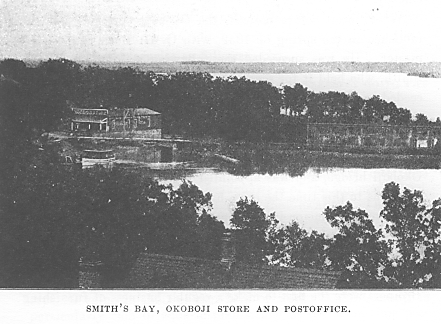
As has been before noticed, the Okoboji postoffice was established in the spring of 1859, with G. H. Bush, Esq., postmaster. He was succeeded the following summer by M. J. Smith, who held it for several years, when he in turn was succeeded by J. W. O'Farrell. There was a great deal more work than pay about the office at that time and nobody wanted it. Along about 1880, or a little before, E. A. Case built a small store and put in a stock of goods in the grove south of the Okoboji bridge, and was appointed postmaster at the time. Previous to this time the office had been kept in private homes, but from this time on it was kept in public places. A few years later Case moved to Milford and S. E. Mills was appointed postmaster. About this time Mr. Mills erected a store building and put in a stock of groceries and camp supplies. Mills Brothers were the first to make a regular business of furnishing boats, bait and fishing tackle for visiting sportsmen. They at once set to work to collect a fleet of boats, and by dint of building some and buying the rest, they soon had one of the most complete fleets of fishing boats ever put on the lake.
About this time the roller skate craze broke out and every place must have its skating rink. A young Norwegian by the name of Louis Kellsen thought to make his fortune by putting in a skating rink. He accordingly effected an arrangement with Mr. Mills whereby they were to erect a suitable building, the basement of which Mills was to occupy as a boat house, while the upper story Mr. Kellsen was to operate as a skating rink. The building was erected and they started in all right, but the skating craze collapsed just about as sudden as it sprung up, and Mr. Kellsen found himself with his rink and several dozen pairs of roller skates on hand. These he finally disposed of to Mr. Mills for much less than they cost him. Mr. Mills partitioned off the skating room and moved the postoffiee and store business into the front room, while the rear he used for storing and painting boats, for which it was well adapted. About 1888 he sold out to W. S. Wilson & Sons, who continued the same line of business, enlarging and improving it to meet the growing demands of their trade. Mr. Wilson was also appointed postmaster, which position he still retains.
The later resorts on West Okoboji are Manhattan Beach, The Inn, Omaha Beach, Hayward's Bay and Pike's Point, at each of which places accommodations more or less elaborate have been provided for the entertainment of summer tourists.
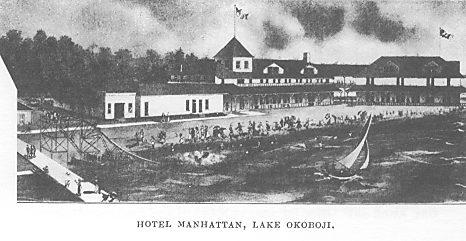
Manhattan Beach is situated on the west shore of West Okoboji Lake, north of Miller's Bay. The project of making a summer resort of this point was first conceived by D. B. Lyon, Esq., of Des Moines, about 1893. He first purchased a large tract of land having more than a mile of lake shore, and through his efforts a joint stock company was organized. A long line of lake shore lots was laid out and put on the market. Cottages were erected and a large pavilion built with dining room, office and other conveniences requisite for a fashionable resort. A roomy bathhouse and toboggan slide were among the attractions. The old steamer, Ben Lennox, was purchased and thoroughly overhauled and the name changed to the "Manhattan," and it was run so as to make all the trains at the Arnold's Park station in the interests of the hotel. Another steamer, a flat bottomed sternwheeler, which was built at Spirit Lake and named the "Robert Williams," was also bought with the intention of running her between Spirit Lake and the Okoboji bridge, there to connect with the "Manhattan." But somehow none of their schemes panned out as planned. Both of the steamers, which were old, when they bought them, rotted down on their hands, and none of their projects proved profitable. The lots didn't sell and the hotel didn't pay. It was too far from the railroad and it cost too much to run it. The expenses exceeded the income and the whole concern went into the hands of a receiver, and the property sold for what it would bring.
A new company has since been organized on a more economical basis with a view of running matters more nearly in accordance with business principles. They have erected several new buildings and repaired, renovated and refurnished the old ones, and made other needed improvements, until the place ranks with the finest resorts about the lakes. The location is a charming one, combining luxuriant shade, sandy beach, rocky shore, clear water and cool breezes to a very enjoyable extent.
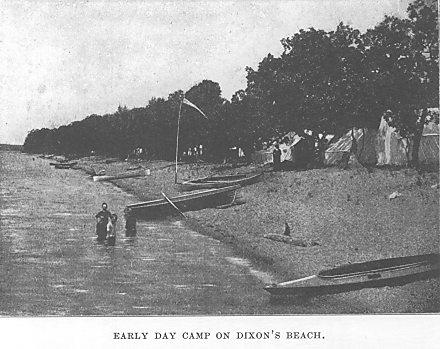
One of the best known and most popular places on West Okoboji was first known as Maple Grove and next as Bennett's Beach, and later as Dixon's Beach. About 1882 Dixon sold out to the railroad company, or rather to a company composed of a few of the railway officials and a few outsiders who conceived the idea of building up a great summer resort at the railroad company's expense. Their scheme was to pocket the profits while the railroad company paid the bills. The death of President Mitchell and Superintendent Merrill both occurring about this time, the management of the road was thrown into the hands of other people who were not in the scheme, and would not, therefore, derive any direct benefit from its success, and they absolutely refused to have anything to do with it, consequently the scheme was abandoned and the parties left to unload their land as best they could.

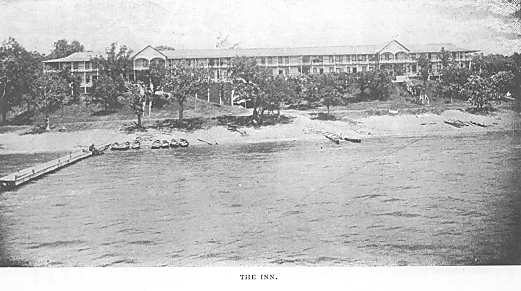
In the course of a few years, after various vicissitudes, the property came into the hands of J. A. Beck, Esq., an experienced hotel man from Fairfield, Iowa, who at once set to work to perfect plans for a first-class summer resort. The location is an ideal one. For many years "Dixon's Beach" was known as one of the finest in Iowa. It has few equals and no superiors. It was in 1896 that Mr. Beck commenced improvements on the place as a summer resort. Previous to that time he had erected cottages and farm buildings and made other improvements in a general way, and that year he built "The Inn," and has since continued to add to the original structure until he has succeeded in producing one of the most unique and popular resorts in the whole lake region. One of the recent Burlington, Cedar Rapids & Northern Railroad advertising circulars speaks of "The Inn" as follows:
"On the eastern shore of the lake, towering over Dixon's Beach, stands 'The Inn,' a fine new summer hotel of eighty rooms, all facing the water, and open to the deliciously cool and refreshing breezes that come across from the southern and western shores. 'The Inn' is equipped with a splendid shore-built pavilion, and for bathing the beach immediately in front has not its equal on the lake. The social life of Okoboji centers at 'The Inn,' with its excellent orchestra and the season witnesses many delightful society events."
In addition to the foregoing many of the more desirable points about the lakes, and more especially about West Okoboji, have been purchased and platted and lots offered for sale, and on most of them improvements of greater or less magnitude have been made. In some cases pavilions, dining rooms and other facilities for the entertainment of summer visitors have been provided. Prominent in this catalogue are Gilley' Beach, Hayward's Bay, Pike's Point, Brownell's Beach, Pocahontas Point, Omaha Beach, Egralharve and possibly some others.
Gilley's Beach is the headquarters of quite a colony of people from Carroll County, prominent among whom are William Gilley, W. L. Culbertson, C. E. Townsend, R. E. Coburn, William Trowbridge and several others. Mr. Gilley was the originator and promoter of the scheme. As early as 1894 he purchased a piece of lake shore property on the east side and pretty well toward the south end of West Okoboji Lake, and laid it off in lots under the name of Gilley's Beach. These lots he disposed of to his friends and neighbors, until there is quite a colony of them who have erected neat cottages on their lots and who come up annually to spend their summers. So far they have made no move toward the erection of buildings for the accommodation of the general public, and it is not understood that such is a part of their plan, the idea being to provide suitable facilities whereby a company of congenial spirits can enjoy their summer vacation in their own way without any possibility of being annoyed by the many objectionable features which are so often prevalent at the summer resorts, and for this purpose no more charming place could be found in the lake region.
William Bascom's place on Minnie Washta is another point which of late has won deserved popularity as a place where can be found neat and quiet accommodations for a limited number of guests in search of rest and recreation, who dislike the turmoil and excitement of the larger and more prominent places.
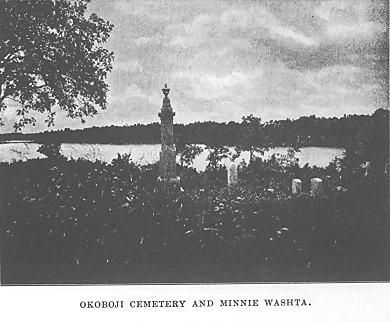
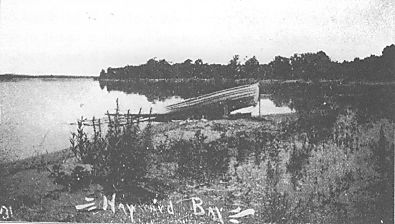
Hayward's Bay, another charming location, is on the eastside of West Okoboji, nearly two miles north of The Inn. This place was originally known as Palmer's Bay, but some years since it became the property of Mr. William Hayward of Spirit Lake, who surveyed and platted a portion of it in lake shore lots. With the people of Spirit Lake this is the most popular point on West Okoboji, and many of them have purchased lots and erected cottages there and spend a portion of each summer enjoying the rest and change afforded by an outing on the sandy shores of Hayward's Bay.
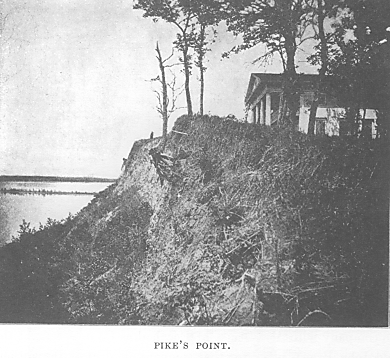
Pike's Point, north of Hayward's Bay, was purchased and laid off by Baum and Patterson, of Omaha, in the early nineties. They erected a spacious pavilion and dining room and built several cottages, and for a few seasons business was rushing with them. It was they who introduced the toboggan slide, they being the first to erect one about the lakes as a means of recreation for the summer tourists. After a few seasons business at this resort rather flagged, and finally it was neglected altogether. But for all this, it is a charming location.
North of Pike's Point is Brownell's Beach. Dr. E. L. Brownell, of Spirit Lake, owns over half a mile of lake shore, which he proposes in the near future to throw open to the public. As yet the only improvements made thereon are a few private cottages, but as the demand for cottage lots increases he will doubtless offer his for sale, many of which rank with the choicest in the lake region.
Egralharve is the location of the famous mineral spring. This place is the property of G. A. Badgerow, of Sioux City. The location is a charming one, the grounds being tastefully laid out and well kept. The place owes its celebrity to a large mineral spring. This spring is located nearly half a mile from the lake shore, from which point the water is brought down in iron pipes to the basin and fountain erected on the grounds by the proprietor. What makes this the more remarkable is that the prairie region about there is devoid of springs of any kind, and this one breaking out as it does with such a magnificent flow excites the surprise of every newcomer. The analysis of the water shows the component parts to be very similar to those of the famous springs at Waukesha, Wisconsin.
Willow Spring Farm at the west side of Miller's Bay has long been a favorite stopping place for a limited number of summer tourists. Like many other favorite stopping places this is not a hotel but a farm house, which has long been famous for the hospitality and good cheer which is generously extended to all newcomers. It has many interesting associations and surroundings. Here is located the celebrated mound and observatory so often pointed out as the highest point in Iowa, and also as the burial place of the mythical chieftain "Okoboji."
Pocahontas Point, situated on Brown's Bay, on the southwest shore of West Okoboji, is another of the choice locations for which that lake is famed. Back in the early eighties, when the different railroad companies were prospecting this region with a view to building in here, the attorney for the Rock Island road, in company with Mr. Bruce, of Pocahontas County, bought the old John Brown place for that company, and after the authorities of the road abandoned the project of building up here at that time, the land went into the hands of others from Pocahontas County and soon after came to be known as Pocahontas Point.
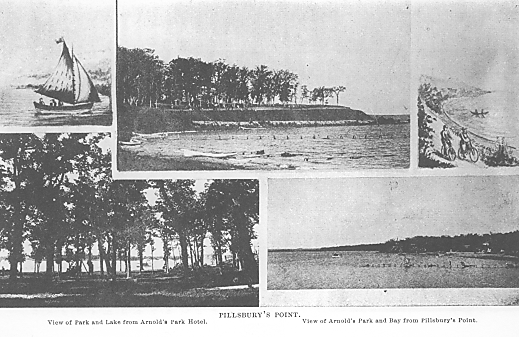
Within the last few years quite a respectable village of summer cottages has grown up at and about Pillsbury's Point. A company of Des Moines capitalists organized what is known as the South Beach Company and purchased several desirable locations, a portion of which they have laid off and platted as cottage lots. On many of these lots some of the finest summer cottages about the lakes have been erected. Judge Given also purchased quite a tract which he laid out and platted, but instead of offering the lots for sale he has erected cottages on many of them which he leases to the families of summer tourists. He already has some eight or ten which he leases that way, and proposes building more in the near future. The place was known as Pillsbury's Point long before any cottages were built, and is better known by that name now than any other. Attempts have at different times been made to adopt a more high sounding name, as "Cass Bay," "Crescent Beach," and possibly some others, but so far without success. This is a part of the old Gardner place of the pioneer days. Here is located the old log cabin which was the residence of the family of Rowland Gardner at the time of the massacre of 1857. Of the half dozen cabins built previous to that time, this is the only one preserved. Here is located the monument erected by the state and dedicated to the memory of the victims of the only Indian massacre ever perpetrated in Iowa. Here was enacted the bloodiest tragedy recorded in Iowa history. Hundreds of visitors every summer make pilgrimages to this historic spot to listen to the unique and tragic story of the sole survivor of this terrible tragedy, and after listening to the heart rending recital they feel that the greatest wonder is that she is there to tell it.
